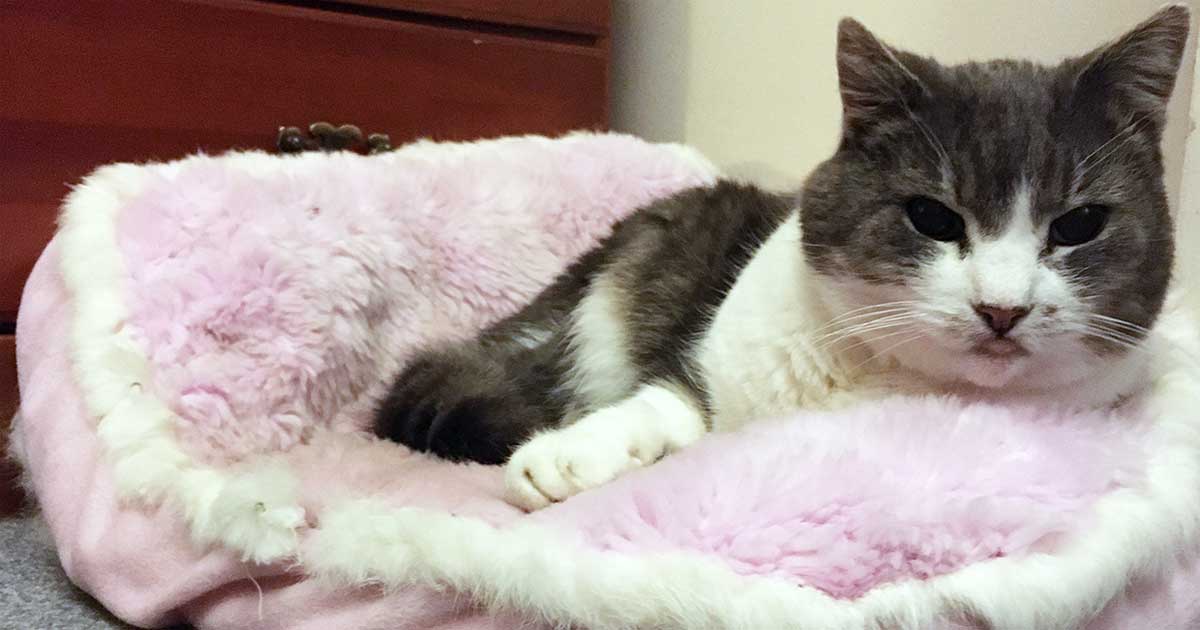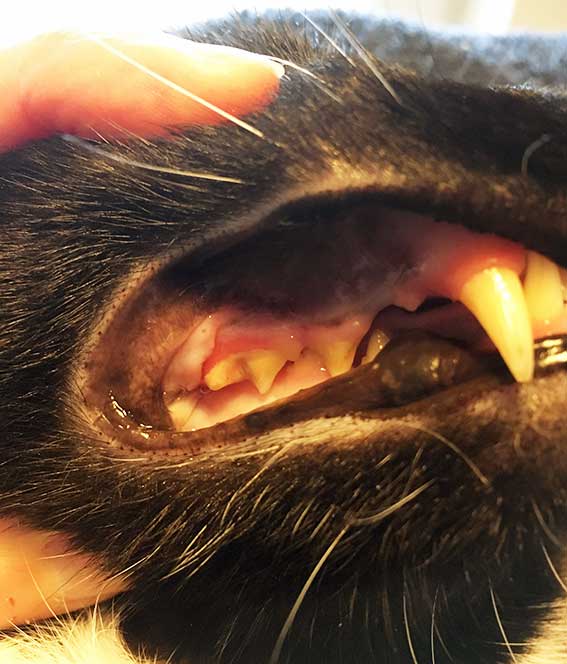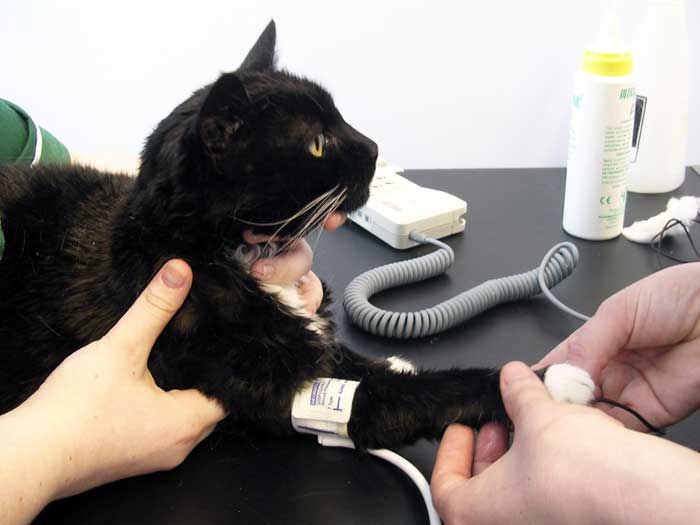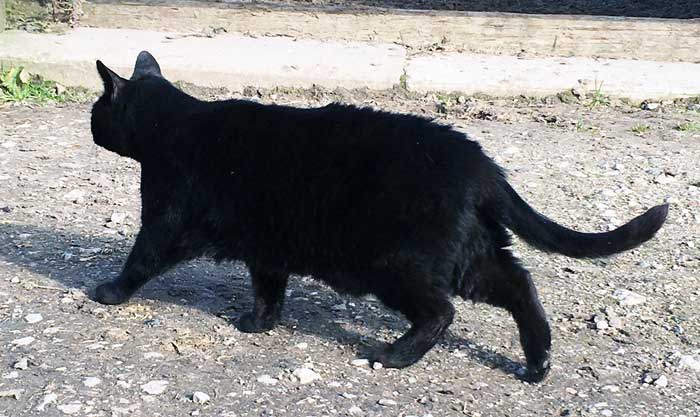25 Nov 2019
Routine health care for older cats
Ellie Mardell outlines some major geriatric disorders in feline patients, and the benefits of early detection and intervention.

Figure 1. This elderly, arthritic cat is comfortable sleeping on a bed tucked away at floor height, in preference to jumping up to a sleeping place.
With increasing interest in preventive medicine and proactive screening for disease, geriatric care forms a significant sector of companion animal medicine.
Due to their relatively sedentary lifestyle, and the fact many cats may spend several hours a day unobserved outside, it is easy for an owner to miss early signs of disease. A cat that, at first glance, appears outwardly well may, on questioning and deeper observation, be showing subtle signs of disease. Various adaptive changes the cat makes to cope with disease may be dismissed as “normal ageing”.
A failure to seek and recognise certain conditions, such as OA, compromises quality of life. Also, in certain diseases, vague and indefinable signs may occur prior to potentially devastating consequences; hypertension is not referred to as “the silent killer” for nothing.
From the cat’s point of view, early detection and intervention is important to prevent avoidable suffering and/or consequences of disease that may cause significant morbidity. From an owner’s perspective, we aim to preserve quality of life and maximise length of life, maintaining a happy feline companion for as long as possible. This article will outline some of the major geriatric disorders that occur in cats, along with a discussion of the benefit of early detection and intervention.
OA
The true incidence of clinically significant OA is not well established in cats. The impact on welfare of OA in elderly cats is probably still underestimated. Radiographic signs of OA are common (present in 95% of elderly cats in a study by Lascelles et al, 2012). These may consist of osteophytes formation, appearing as roughening of the joint surface or more obvious bony spurs, secondary soft tissue swelling, and in advanced cases bone remodelling and sclerosis of subchondral bone. Various joints and the spine can be affected.
Frustratingly, these changes do not always correlate well to examination findings (Lascelles et al, 2012). Joint discomfort, crepitus and/or reduced range of motion may be apparent, but a hands-on assessment can only ever form part of the database when assessing for OA in a cat. What matters to the patient is the degree of pain experienced day to day. This is not always easy to determine – partly because no well accepted standard technique for pain assessment in cats exists.
Signs are rarely overt lameness, but more usually decreased activity levels, decreased grooming, difficulty using the litter tray, reduced ability or willingness to jump or climb, and resentment of handling. Cold and damp weather typically exacerbates signs, and discomfort and stiffness will usually be worse after a rest following exercise. Evidence of decreased stropping and grooming may be apparent on examination if the claws and/or coat are ill kempt.
Careful questioning of the owner as to the cat’s demeanour, activity levels, and range of activities and behaviours expressed may reveal clues indicating the cat is experiencing significant discomfort. A review by Bennet et al (2012) contained a comprehensive questionnaire that can be presented to an owner to determine their cat’s comfort levels.
Benefit of early detection
It is possible early treatment of OA could retard the degradation of cartilage if certain up-regulated enzymes are targeted. Evidence for this is weak at best. However, to advocate for the patient, we have an ethical responsibility to detect and manage pain at the earliest opportunity. The potential side benefits of early action should also not be ignored; a more comfortable patient will be more active, helping to preserve muscle mass, and obesity can be addressed or avoided, reducing unnecessary exacerbation of joint disease.
A holistic approach to treatment of OA achieves the best results. The environment can be modified (Figure 1), providing ramps to litter trays and beds, and slopes placed over steps. Weight loss is advised in obese cats. Dietary supplementation of omega-3 fatty acids has proven efficacy (Lascelles et al, 2010). Pain relief and control of inflammation is also achieved via the use of NSAIDs.

Dental disease
Most owners cannot – or do not – address the dental hygiene of their cat on a daily basis. Although dental disease can commence and progress at any age, it is likely to become more prevalent and severe with advancing age.
A tendency perhaps exists to diminish the importance of dental disease in an elderly animal, or to shy away from addressing dental problems because of concern over the impact of general anaesthesia on ageing and potentially ailing organs.
Benefit of early detection
Dental pain is underestimated. Cats with dental disease do continue to eat; however, in an elderly feline patient, oral pain can contribute to poor nutritional intake and weight loss. As with OA, we have an ethical responsibility to address pain in our patients, and dental disease can be better managed with surgical procedures and dental scaling than palliative antibiotics and analgesia.
An elderly cat with dental disease has the potential for various comorbidities that may increase anaesthetic risk. Early detection of dental disease (Figure 2) will hopefully allow treatment to be carried out while the benefit clearly outweighs any risk. The presence of severe dental disease has been associated with the development of azotaemic chronic kidney disease (CKD; Finch et al, 2016). Early treatment is, therefore, indicated to prevent avoidable decline in renal health.

Hypertension
Systemic hypertension is commonly encountered in older cats, but early outward signs can be subtle or absent. In most cases, hypertension is present because of an identifiable underlying disease. Chronic kidney disease, hyperthyroidism and hyperaldosteronism are the most common causes of hypertension. In some cases, a cause of systemic hypertension cannot be found. Such idiopathic cases should be managed with anti-hypertensive agents, and periodically reviewed to determine whether an underlying cause of hypertension has become apparent.
Benefit of early detection
Hypertension is easily and relatively cheaply discovered (Figure 3). Its presence can indicate the necessity to seek certain underlying causes. Moreover, the finding of hypertension may encourage an owner to proceed with such investigations. Most importantly, even if an owner is reluctant to continue investigations, the hypertension itself can be addressed, which will prevent potentially devastating target organ damage to the eye, brain, kidney and heart. The subsequent reduction in patient morbidity and mortality should be considered as a major motivation to proactively screen for hypertension in elderly cats.

CKD
One of the great (and ongoing) quests of feline medicine over the past few years has been to identify the cause of – and progression factors for – CKD. While the cause remains elusive, various progression factors are now accepted. Elevated creatinine with concurrent submaximally concentrated urine is the conventional way to diagnose CKD.
Symmetric dimethylarginine measurement may be able to detect decline in renal function somewhat earlier. For conclusive diagnosis in equivocal cases, glomerular filtration rate (GFR) measurement is necessary. That said, only very weak evidence exists that intervention prior to International Renal Interest Society (IRIS) stage two disease is of any benefit, and this can usually be detected with the combination of creatinine and urine specific gravity.
Benefit of early detection
By identifying CKD early, the patient can be gradually transitioned to an appropriate diet at a stage where acceptance is maximised and benefit proven. Several studies have shown a renal diet increases lifespan and reduces the frequency of uraemic episodes (Ross et al, 2006; Elliot et al, 2000; Plantinga et al, 2005).
Proper attention can be given to ensuring adequate water intake to maintain optimum hydration. Regular monitoring can be organised to check for consequences of renal disease that may perpetuate the condition and/or reduce quality of life, such as anaemia, hypertension, hyperphosphataemia, hypokalaemia, proteinuria and pyelonephritis.
For most of these factors, there is a lack of conclusive evidence that therapeutic intervention lengthens life and/or slows progression of CKD. Conversely, several such consequences of renal disease, such as hypertension, and hypokalaemia, if left untreated, could certainly hasten the progression of CKD and, importantly, have a significant negative impact on quality of life. Both CKD and degenerative joint disease are seen with some frequency in the elderly feline population. A study suggested CKD could be expected in nearly 70% of cats with OA (Marino et al, 2014).
Concerns that NSAIDs would be harmful to the kidney – particularly when interstitial nephritis is present – have been allayed by studies that have shown NSAIDs do not cause or exacerbate renal dysfunction (Gowan et al, 2011; 2012). NSAIDs do, however, have the potential to precipitate acute kidney injury (AKI) in cats with CKD, if the patient is dehydrated, hypotensive or hypovolaemic.
In CKD, renin-angiotensin-aldosterone system activation has already occurred and the kidney can protect itself no further against reduced circulating volume; the efferent arteriole is already constricted under the effect of angiotensin II. NSAIDs inhibit the synthesis of prostaglandin, which would otherwise lead to afferent arteriolar dilation.
In a well-hydrated patient, even with CKD, good renal perfusion prevents reduced GFR, but if the patient also becomes dehydrated, no additional measures exist that the glomerulus can take to protect itself against reduced perfusion, and AKI may result. This means NSAIDs can be safely used in a geriatric, painful patient, but an awareness of the concurrent presence of CKD is valuable as the owner can maintain extra vigilance for inappetence, vomiting or diarrhoea, necessitating prompt suspension of NSAID treatment.
Regular renal function monitoring is also indicated, as cats progressing to IRIS stage IV CKD may be unsuitable candidates for NSAID use as inappetence and polyuria are likely to be more marked, and these cats may struggle to maintain hydration. Alternative treatments for cats that cannot tolerate NSAIDs may include oral buprenorphine, tramadol or gabapentin.
Hyperthyroidism
The most common endocrine disease of older cats, hyperthyroidism will inevitably be encountered with some frequency in small animal practice. The condition is generally easy to diagnose; on occasion, it may be subtle or atypical in its presentation – particularly in early or mild cases, or if some concurrent disease exists. Detecting these cases may require extra awareness and attention to historical details, examination findings and blood results.
Benefit of early detection
The earlier hyperthyroidism is addressed, the smaller the negative impact will be on the heart and kidneys. Curative treatment (surgical thyroidectomy or radioactive iodine treatment) should be considered for a hyperthyroid cat, as this brings the best prognosis. A curative procedure is simpler and safer to carry out, and is a more appealing option if it is undertaken before time has elapsed for secondary organ damage to occur.
Moreover, the chance of transformation from a thyroid adenoma to a carcinoma increases significantly and rapidly with time (Peterson et al, 2016), such that late detection of hyperthyroidism may mean the chance of a cure is lost. Finally, taking the long view, if hyperthyroidism is detected and treated as early as possible, it removes the chance it will, in the future, be a complicating comorbidity with any other condition the cat may develop.
Diabetes mellitus
Another common endocrine condition of older cats is diabetes mellitus (DM). This rarely presents a diagnostic challenge and, assuming prompt presentation by the owner, early detection should be simple using repeat blood glucose and urinalysis, or fructosamine levels.
Benefit of early detection
In recent years, the full implications of the relative insulin deficiency in diabetic cats has been better appreciated. A frequent aim is to achieve remission where possible in feline DM. Studies have shown the biggest factor in whether remission is achieved is the speed and completeness of overcoming persistent (or, when under treatment, even intermittent) hyperglycaemia and, therefore, glucose toxicity (Roomp et al, 2012; Gostelow et al, 2014).
Late diagnosis and treatment of DM may mean the chance to achieve remission is lost. Added to this, an undiagnosed diabetic is more likely to develop life-threatening ketoacidosis, and even if this does not occur, morbidity will be increased as weight loss and secondary metabolic complications will become more likely and/or more severe.
Neoplasia
Clients often hope blood tests can either detect or exclude neoplasia. Of course, this is rarely the case, and performing any kind of proactive “screen” for neoplasia is rarely appropriate. However, a wide variety of signs (including something as non-specific as weight loss or inappetence) could prompt investigations that lead to a diagnosis of cancer.
Benefit of early detection
If a definitive treatment modality is to be sought (invariably surgery) then the size of the tumour and the presence or absence of metastasis will dictate success rates, and clearly metastatic potential increases with time. For chemotherapy, tumour burden again impacts on efficacy.
For untreatable cancers, early detection may do nothing more than allow an owner to come to terms with the diagnosis, but even this can be appreciated by an anxious client, and palliative care of their pet also can be instigated, where required, to alleviate any pain, discomfort, nausea or anorexia that may result from tumour presence.
General considerations for care of geriatric cats
Aside from the detection of disease, regular contact with elderly patients affords the opportunity to discuss aspects of geriatric care that may otherwise be overlooked. Cats should be body and muscle conditioned scored.
Diet can be tailored to age and body condition, and a calorie-controlled or a highly digestible, high-quality protein diet can be instituted for cats showing weight and muscle loss that frequently accompanies advancing age (sarcopenia). “Geriatric” diets often incorporate some phosphate (but not protein) reduction in case of equivocal renal function (Figures 4a and 4b).


Vaccination status of the older pet also deserves consideration. Excessive vaccination is to be avoided in younger animals – particularly in cats where it has been associated with the development of azotaemic kidney disease (Finch et al, 2016).
However, immune system function tends to decline with age and this is the correct time to consider re-introduction of panleukopenia vaccination, or increasing the frequency of antibody titre assessment to yearly. Flu and leukaemia virus vaccination is based on risk of exposure, and this may have altered with any change in the cat’s lifestyle – for example, spending less time outdoors or in the company of other cats.
Regular preventive health care consultations for geriatric patients promote early detection of disease and prompt intervention (cure where possible, management otherwise).
Additionally, they provide a forum for proactive discussion of appropriate lifestyle changes and vigilance for the more subtle signs of diseases that may otherwise be overlooked as inevitable consequences of ageing.
